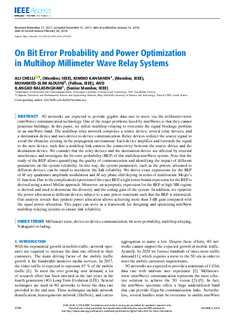| dc.contributor.author | Chelli, Ali | |
| dc.contributor.author | Kansanen, Kimmo | |
| dc.contributor.author | Alouini, Mohamed-Slim | |
| dc.contributor.author | Balasingham, Ilangko | |
| dc.date.accessioned | 2019-09-20T05:57:46Z | |
| dc.date.available | 2019-09-20T05:57:46Z | |
| dc.date.created | 2019-01-22T14:52:09Z | |
| dc.date.issued | 2018 | |
| dc.identifier.citation | IEEE Access. 2018, (6), 3794-3808. | nb_NO |
| dc.identifier.issn | 2169-3536 | |
| dc.identifier.uri | http://hdl.handle.net/11250/2617936 | |
| dc.description.abstract | 5G networks are expected to provide gigabit data rate to users via the millimeter-wave (mmWave) communication technology. One of the major problems faced by mmWaves is that they cannot penetrate buildings. In this paper, we utilize multihop relaying to overcome the signal blockage problem in an mmWave band. The multihop relay network comprises a source device, several relay devices, and a destination device and uses device-to-device communication. Relay devices redirect the source signal to avoid the obstacles existing in the propagation environment. Each device amplifies and forwards the signal to the next device, such that a multihop link ensures the connectivity between the source device and the destination device. We consider that the relay devices and the destination device are affected by external interference and investigate the bit error probability (BEP) of this multihop mmWave system. Note that the study of the BEP allows quantifying the quality of communication and identifying the impact of different parameters on the system reliability. In this way, the system parameters, such as the powers allocated to different devices, can be tuned to maximize the link reliability. We derive exact expressions for the BEP of M-ary quadrature amplitude modulation and M-ary phase-shift keying in terms of multivariate Meijer's G-function. Due to the complicated expression of the exact BEP, a tight lower bound expression for the BEP is derived using a novel Mellin-approach. Moreover, an asymptotic expression for the BEP at high SIR regime is derived and used to determine the diversity and the coding gain of the system. In addition, we optimize the power allocation at different devices subject to a sum power constraint such that the BEP is minimized. Our analysis reveals that optimal power allocation allows achieving more than 3-dB gain compared with the equal power allocation. This paper can serve as a framework for designing and optimizing mmWave multihop relaying systems... | nb_NO |
| dc.language.iso | eng | nb_NO |
| dc.publisher | Institute of Electrical and Electronics Engineers (IEEE) | nb_NO |
| dc.title | On Bit Error Probability and Power Optimization in Multihop Millimeter Wave Relay Systems | nb_NO |
| dc.type | Journal article | nb_NO |
| dc.type | Peer reviewed | nb_NO |
| dc.description.version | publishedVersion | nb_NO |
| dc.source.pagenumber | 3794-3808 | nb_NO |
| dc.source.journal | IEEE Access | nb_NO |
| dc.source.issue | 6 | nb_NO |
| dc.identifier.doi | 10.1109/ACCESS.2018.2791989 | |
| dc.identifier.cristin | 1663118 | |
| dc.description.localcode | 2018 IEEE. Translations and content mining are permitted for academic research only. | nb_NO |
| cristin.unitcode | 194,63,35,0 | |
| cristin.unitname | Institutt for elektroniske systemer | |
| cristin.ispublished | true | |
| cristin.fulltext | original | |
| cristin.qualitycode | 1 | |
